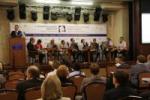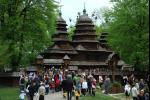- عربي
- Ukraine
- Economy
-
Investment
- Current Investment Trends
- Legal Conditions of Doing Business
- Investment Policy
- Competition
- Setting a Business in Ukraine
- Mergers and Acquisitions
- Taxation
- Import and Export
- Banks and Bank Regulation
- Convertibility and Profits Repatriation
- Currency Regulation
- Protection of Intellectual Property Rights
- Companies
- Travel to Ukraine
- About us
- Useful Sites
- Gallery
- News
Currency rates in UAH
| AED | ||
| BHD | ||
| EGP | ||
| KWD | ||
| LBP | ||
| OMR | ||
| QAR | ||
| SAR | ||
| SYP |
2015-07-06
| Kiev |  |
+32 |
| Donetsk |  |
+28 |
| Dnipropetrovsk |  |
+31 |
| Lviv |  |
+31 |
| Odessa |  |
+27 |
President
HistoryBeginning of the Ukrainian democracy was originated in the Cossack period but its rapid development and the establishment of the Institute of Presidency started in the tenths of the XX century. During the Central Rada (Council) activity four edicts were issued that were the foundations for democracy of the Ukrainian society. The Central Rada (Council) proclaimed complete political independence of Ukraine from Russia with the last edict of January 22, 1919. On April 29, 1918, this body elected Mykhailo Hrushevsky as the President of the Ukrainian National Republic.
On December 1, 1991 another significant event had taken place in the history of the Ukrainian Presidency. That day people voted for proclamation of Ukraine’s independence and elected the first President of a new Ukrainian State – Leonid Kravchuk.
Firstly, in 1994 people elected the next President of Ukraine by means of elections. The Head of the State Leonid Kuchma became the President of Ukraine. On January 23, 2005 Victor Yushchenko was inaugurated as the third President.
The 4th President of Ukraine is Viktor Yanukovych, who was elected on February 7, 2010 by the results of national vote. On February 25 he swore the oath of the President of Ukraine.
On 18 June 2015 Yanukovych was officially deprived of the title of President of Ukraine. The current president is Petro Poroshenko who took the oath of office on June 7, 2014
Election
The citizens of Ukraine elect the President of Ukraine for a five-year term by means of universal, equal, direct suffrage by secret ballot.
Structure
- Presidential Secretariat;
- Permanent Representative of the President of Ukraine in the Constitutional Court of Ukraine;
- State Protocol and Ceremonial Office of the President of Ukraine;
- Office for relations with the Verkhovna Rada of Ukraine,
- The Constitutional Court of Ukraine and the Cabinet of Ministers of Ukraine;
- Consultative Council;
- Council of National Security and Defence of Ukraine;
- Regional Administrations.
Duties
The President of Ukraine is the Head of State and the highest official in the system of state authorities. According to Article 102 of the Constitution, the President is the guarantor of state sovereignty and territorial indivisibility of Ukraine, the observer of the Constitution and human rights and freedoms. The President should not be the head or a member of any branch of the power. The President represents the State and the government as a whole. The President as the Head of State is vested with authorities to act on its behalf in Ukraine and abroad. The President also is the Guarantor of state sovereignty and territorial integrity, elected by state direct suffrage for a five-year-term and enjoys the right of immunity during the term of authority.
Principal authorities in the spheres of:
- Legislation- the right of legislative initiative, to veto laws adopted by the Verkhovna Rada (Supreme Council);
- Executive power – to dismiss the Prime Minister, to revoke acts of the Cabinet of Ministers;
- Military-political – the Commander–in-Chief of the Armed Forces of Ukraine, the Head of the Council of National Security and Defence of Ukraine;
- Personnel formation.
List of presidential appointments
- Heads of diplomatic missions of Ukraine (ambassadors)
- Prime Minister of Ukraine (consent of Verkhovna Rada), in 1996-2004 and 2010-2014
- Procurator General of Ukraine (consent of Verkhovna Rada)
- Chairman of the Anti-monopoly Committee of Ukraine (consent of Verkhovna Rada)
- Chairman of the State Property Fund of Ukraine (consent of Verkhovna Rada)
- Chairman of the State Committee of Ukraine on Television- and Radio-broadcasting (consent of Verkhovna Rada)
- Members of Cabinet of Ministers of Ukraine (submission of Prime-Minister)
- Members of other central bodies of executive power (submission of Prime-Minister)
- Heads of local government (submission of Prime Minister)
- Members of the Council of the National Bank of Ukraine (one-half of the composition)
- Members of the National Council of Ukraine on Television- and Radio-broadcasting (one-half of the composition)
- The High Command of the Armed Forces of Ukraine and main military formations
- Constitutional Court of Ukraine (one-third of the composition)
- Head of the Presidential Administration of Ukraine
- Presidential first aide
- Presidential press secretary
Issues subordinate legislation, decrees and orders.
If the President should be unable or unwilling to carry out the duties of office, the Speaker of the Verkhovna Rada becomes the acting president until a new president is elected. The powers of an acting president are restricted, however: an acting President does not have the power to address the nation and legislature, cannot dismiss the legislature or nominate members of the Government or judges. An acting president also cannot call for a referendum or grant military rank.
If both the president’s and speaker’s posts are vacant, there are no constitutional provisions for presidential succession
The Legal Basis
The President of Ukraine acts in the name of the Constitution of Ukraine, in accordance with the Law of Ukraine “On Elections of the President of Ukraine”, the Law “On All-Ukrainian and local referendums”, the Law of Ukraine “On public appeals”.
Changes in 2014
On Feb. 22, 2014, the Verkhovna Rada dismissed Viktor Yanukovych as president with a vote of 328 in favor (the constitutional majority is 300 votes) and called for early presidential elections on May 25 (Originally scheduled to take place on 29 March 2015, the date was changed following the 2014 Ukrainian revolution).
The newly-elected Speaker, Oleksandr Turchynov, the closest ally of former PM Yulia Tymoshenko, became the acting President in the interim. The Rada also approved a return to the 2004 Constitution, which was a turning point in Ukraine’s history, as this Constitution limits presidential powers and provides a better balance of power between president, legislature and Government.
The 2004 Constitution no longer gives the President the power to nominate the Preme Minister, transferring this power to the legislature instead. The President now may only appoint the Defense Minister and the Foreign Minister. The President also lost the right to dismiss members of the Cabinet (the government) but gained the right to dissolve the Verkhovna Rada and to appeal to the nation’s voters.
The results of the May 25, 2014 vote brought Petro Poroshenko to power in the first round. Poroshenko won the elections with 54.7% of the votes. His closest competitor was Yulia Tymoshenko, who emerged with 12.81% of the votes. The Central Election Commission reported voter turnout at over 60% excluding those regions not under government control.
The elections were not held throughout Ukraine. During the 2014 Crimean crisis, Ukraine lost control over Crimea, which was unilaterally annexed by Russia in March 2014. As a result, elections were not held in Crimea. In the Donbass region of Ukraine (Donetsk and Luhansk Oblasts that have 6.6 million residents ) only 20% of the ballot stations were open due to threats and violence by pro-Russia separatists.
Since Poroshenko obtained an absolute majority in the first round, a run-off second ballot (on 15 June 2014) was unnecessary. Poroshenko will serve a five-year term in office.
The post of President remains the most influential post in Ukrainian politics. The President now controls:
- A growing and strengthening Army and Security Service of Ukraine (SBU);
- A strengthened Security Council that has become quite an influential agency having an impact not only on security issues, but on internal politics as well and the balance of power among the executive, legislative and judiciary branches;
- An Anti-Corruption Bureau, a new agency established to fight corruption at the highest level among public officials;
- Lustration processes with power to overrule decisions of lustration committees [Lustration is related to the process of “vetting”, which is, in general terms, evaluation and examination process in order to eliminate abusive and corruptive officials through due procedure;
- National Guard, a military agency directly subordinated to the President with over 60,000 personnel, etc.
The President has also reinforced his control over Governors. In 2014, many of the Governors were appointed on the basis of an agreement with local elites. From August thru December 2014, many Governors were quite independent from their de-jure supervisor, the President. But from January thru March 2015, especially after the resignation of Ihor Kolomois'kyi, an oligarch and a Governor of Dniproppetrovs'k oblast, the President established full control over Governors.
After two years in power, Petro Poroshenko remains one of the most popular politicians in Ukraine. In spite of economic and war problems, his support in February 2016 was 17,2% among Ukrainians (with closest competitor Yulia Tymoschenko gathering 15,9%).
Contacts
You may send requests to the President of Ukraine to:
11, Bankova str., Kyiv–220, 01220, Ukraine,
Tel.: (044) 291 50 71; (044) 226 20 77
URL: http://www.president.gov.ua/
Information from the official web-site of the President of Ukraine



